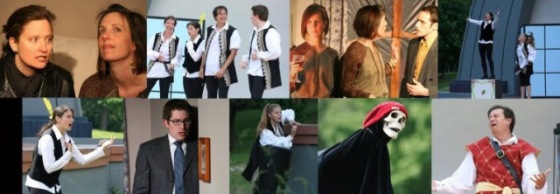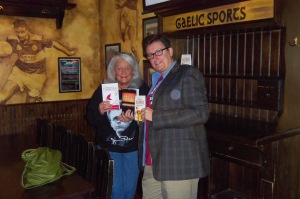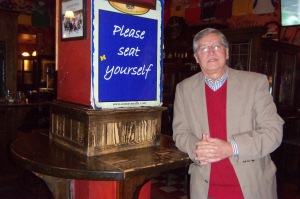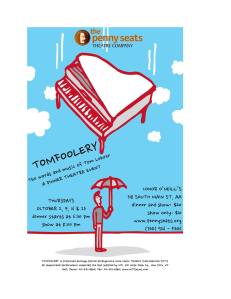![And presenting: ALL of Jake's Women. His girlfriend, his therapist, his sister, his wife, his late wife, his daughter aged 21 and 12. November 14-December 7. A heartwarming comedy by Neil Simon. [Photo by Melissa Tremblay of Platinum Imagery.]](https://reelroyreviews.files.wordpress.com/2014/11/1529859_754215797994833_3842075267912951949_o1.jpg?w=357&h=255)
And presenting: ALL of Jake’s Women. His girlfriend, his therapist, his sister, his wife, his late wife, his daughter aged 21 and 12. Through December 7. [Photo by Melissa Tremblay of Platinum Imagery.]
Simon’s semi-autobiographical memory play Jake’s Women, thereby is an interesting conundrum. First produced in 1990 and starring Alan Alda, the show is Simon’s post-mid-life-theatrical-crisis-writ-large. Simon literally and figuratively exorcises the the ghosts of women who have influenced and shaped his work. Take that, Joan Baim! And that, Marsha Mason! And that … Elaine Joyce?!? In the wrong hands, the play could be an exercise in misogyny at worst or farcical foolishness at best – a kind of Borscht Belt version of Fellini’s 8 1/2 (itself later staged/musicalized by Maury Yeston as Nine).
I am happy to report that the sparkling ensemble in Two Muses’ current production of Jake’s Women (directed by Bailey Boudreau) hits all the right notes. Given that Two Muses’ mission is to promote and celebrate the artistic contributions of women, this play is an inspired and intriguing choice. In lead actor Robert Hotchkiss, the production gives us a sensitive and grounded Jake, informed and haunted as much by modern life/sensibilities as he is by any kind of cooked-up gender war.
Jake’s marriage to whip smart corporate warrior Maggie is failing as he has never gotten past the death of his first wife Julie. The past and present collide as Dickensian specters (wives, daughter, therapist, sister, paramour) shadow Jake’s every move, given vibrant, intrusive life by his crumbling mental state. Jake as a writer is forever trapped in his own head, revisiting the past as a means of understanding the present yet never truly living in any moment. Jake’s laptop computer is an omnipresent stage symbol of the wall he puts between himself and the rest of humanity. I suspect anyone with a smart phone can relate to that.
As Maggie, Amy Morrissey provides the perfect counterpoint to Jake’s neuroses. She has a tricky task of playing Maggie both in the present day and as an idealized Maggie from the early days of their relationship. The actress shows great warmth and humor for the material but is never sidelined by Simon’s more misogynistic tendencies. Maggie is a person first and foremost, as she intones to Jake in one of their later conversations.
The ensemble work is particularly strong in this production. Charlotte Weisserman as Jake’s 12-year-old daughter Molly beams with a mischievously angelic presence – as does Barbie Weisserman as Jake’s sister, the chaotically big-hearted filmmaker Karen. (No shock there I supposed as Charlotte clearly has inherited some lovely, natural stage gifts from her talented real-life mom Barbie.)
Some of the production’s most emotionally affecting moments come from the theatrical mother-daughter team of Meredith Deighton as Jake’s late wife Julie and Egla Kishta as college-age Molly. The familial dynamic achieved between Alexander, Kishta, and Hotchkiss during the play’s second act is remarkable – deeply felt with a comfort and ease rarely seen on any stage.
It wouldn’t be a Neil Simon show without some broad comic relief. Margaret Gilkes is sharp-edged fun as Jake’s saucy therapist Edith, aided and abetted by some of the script’s best zingers, which Gilkes nails with Elaine Stritch-y aplomb. Luna Alexander as Jake’s of-the-moment mistress has the show’s most raucous scene (think The Odd Couple‘s Pigeon Sisters by way of The Jersey Shore‘s Snooki and Jwoww), and she wrings every bit of rimshot glee from her second act moment.
Like the majority of Two Muses’ output, the production values are spot-on, with clever and efficient use of the space, detailed but never overdone set dressing, classic character driven costuming, and an evocative lighting plot.
Back to Jake: Hotchkiss builds his character beautifully, giving us a broken soul who is not just relatable but a lot of fun to watch. Jake’s journey is a difficult one to convey on stage, rife with potentially self-indulgent pitfalls, but Hotchkiss is very smart, warm, and wry and never panders to the audience or to his character’s many, many flaws.
Jake follows a similar arc to Company‘s Bobby, never sure who he really is and only finding motivation by pinging off the input of others. Unlike Sondheim, however, Simon offers Jake a bit more redemption. Hotchkiss does a fine job walking Jake’s circuitous path as he realizes that snark and witty wordplay do not healthy flesh-and-blood relationships make. The play’s script leaves us with an ambiguously happy ending, as Jake and Maggie set off to resolve their differences, but the rich performances by Hotchkiss and Morrissey overlay that denouement with a believable and honest sense of the couple’s future chances.
The play runs through December 7 at Two Muses Theatre. Two Muses Theatre performs in the Barnes & Noble Booksellers Theatre Space, 6800 Orchard Lake Rd, West Bloomfield, MI 48322, South of Maple (15 Mile). Enter the bookstore, and the theatre is on the left. Tickets can be purchased online here or by calling 248.850.9919 (Box Office Hours: By phone: 10am-5pm. In person at the theatre, 60 minutes prior to all performances.)
________________________
Reel Roy Reviews is now a book! Thanks to BroadwayWorld for this coverage – click here to view. In addition to online ordering at Amazon or from the publisher Open Books, the book currently is being carried by Bookbound, Common Language Bookstore, and Crazy Wisdom Bookstore and Tea Room in Ann Arbor, Michigan and by Green Brain Comics in Dearborn, Michigan. My mom Susie Duncan Sexton’s Secrets of an Old Typewriter series is also available on Amazon and at Bookbound and Common Language.

![Description: Film poster; Source: Wikipedia [linked]; Portion used: Film poster only; Low resolution? Sufficient resolution for illustration, but considerably lower resolution than original. Other information: Intellectual property by film studio. Non-free media use rationales: Non-free media use rationale - Article/review; Purpose of use: Used for purposes of critical commentary and illustration in an educational article about the film. The poster is used as the primary means of visual identification of this article topic. Replaceable? Protected by copyright, therefore a free use alternative won't exist.](https://reelroyreviews.files.wordpress.com/2014/11/mockingjay-part-1.jpg?w=197&h=300)


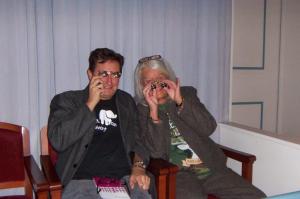

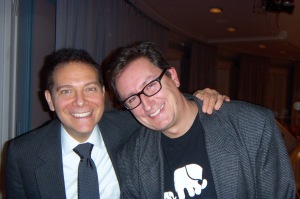
![Description: Film poster; Source: Wikipedia [linked]; Portion used: Film poster only; Low resolution? Sufficient resolution for illustration, but considerably lower resolution than original. Other information: Intellectual property by film studio. Non-free media use rationales: Non-free media use rationale - Article/review; Purpose of use: Used for purposes of critical commentary and illustration in an educational article about the film. The poster is used as the primary means of visual identification of this article topic. Replaceable? Protected by copyright, therefore a free use alternative won't exist.](https://reelroyreviews.files.wordpress.com/2014/11/interstellar.jpg?w=192&h=300)
![Description: Film poster; Source: Wikipedia [linked]; Portion used: Film poster only; Low resolution? Sufficient resolution for illustration, but considerably lower resolution than original. Other information: Intellectual property by film studio. Non-free media use rationales: Non-free media use rationale - Article/review; Purpose of use: Used for purposes of critical commentary and illustration in an educational article about the film. The poster is used as the primary means of visual identification of this article topic. Replaceable? Protected by copyright, therefore a free use alternative won't exist.](https://reelroyreviews.files.wordpress.com/2014/11/nightcrawler.jpg?w=201&h=300)
![Description: Film poster; Source: Wikipedia [linked]; Portion used: Film poster only; Low resolution? Sufficient resolution for illustration, but considerably lower resolution than original. Other information: Intellectual property by film studio. Non-free media use rationales: Non-free media use rationale - Article/review; Purpose of use: Used for purposes of critical commentary and illustration in an educational article about the film. The poster is used as the primary means of visual identification of this article topic. Replaceable? Protected by copyright, therefore a free use alternative won't exist.](https://reelroyreviews.files.wordpress.com/2014/11/big-hero-6.jpg?w=209&h=300)
![Description: Film poster; Source: Wikipedia [linked]; Portion used: Film poster only; Low resolution? Sufficient resolution for illustration, but considerably lower resolution than original. Other information: Intellectual property by film studio. Non-free media use rationales: Non-free media use rationale - Article/review; Purpose of use: Used for purposes of critical commentary and illustration in an educational article about the film. The poster is used as the primary means of visual identification of this article topic. Replaceable? Protected by copyright, therefore a free use alternative won't exist.](https://reelroyreviews.files.wordpress.com/2014/11/birdman.jpg?w=202&h=300)
